Ready to give up your lawn?
by Lora Hein originally featured in My Edmonds News.
As warmer days and clearer skies arrive at last, many of us are itching to get outside. The ditty often attributed to Ogden Nash (but not his) springs to mind:
“Spring is sprung, the grass is ris.
I wonder where the birdies is.”

L-R: Before — our suburban lawn and now — armeria, thyme and ajuga.
A few days ago, I stepped outside, ready to tackle whatever the garden needed. I took a deep breath, inhaling mingled scents of Daphne odora and daffodils. Birds sang from one direction, then another. Not so long ago the spring chorus was a cacophony. I recalled reading Rachel Carson’s warning of a future “Silent Spring.” That future, like objects in the side view mirror, may be closer than expected.
No sooner had I begun snipping dead branches and weeds, than the first rrrr-rummmm, rmmm, rmmmm began in one direction and then another and another. If the birds were still warbling, I could no longer hear them above the rumble, roar and whine of gas-powered mowers and trimmers.
I could stay outside and continue my quiet puttering, pulling, and trimming, breathing air rapidly losing its scent to fumes from machines, or I could abandon my gardening pleasure and retreat inside. I chose the latter, waiting until the noise subsided.
How many arguments for abandoning the lawn and switching it out for alternatives can you find in these first paragraphs?
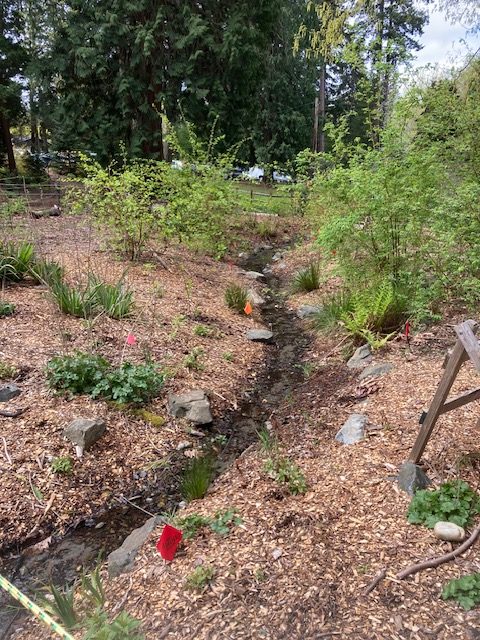
Lawn-free at City Park
The lawn as a symbol of landed gentry has outlived its purpose. My paternal grandparents had a patch of lawn in the middle of their landscaped yard. He was a renowned landscaper, and his own garden was testimony to his design aesthetic. He also taught organic gardening and composting classes at the local community college. My grandmother paid me a nickel for every dandelion root I presented her. The reason we had dandelions to pull was that my grandparents eschewed the use of pesticides, or, as Rachel Carson called them in her seminal work, “biocides.”
The trend of home lawns did not catch on until after World War ll. Access to automobiles and migration to the suburbs spawned an industry to make private lawns as green and expansive as golf courses. The 40-hour work week gave people “leisure time” to maintain their weed-free, uniform green lawns.
The business of turf development and synthetic fertilizers to get that green to grow evenly and robustly grew along with sales of machines and tools to keep that rampant growth in check. Despite Carson’s warning, we couldn’t foresee that the lawn might be the death knell to the natural world we needed more than empty space in front of homes.
When my spouse and I moved to Edmonds, we claimed one of these suburban single-family residences for ourselves, complete with the lawn that dominated the yard.
We found a used manual rotary mower at Goodwill and mowed our level lot in less than an hour. That was still almost an hour every week for months, hours I could have been planting and harvesting vegetables, trimming back bushes, hand watering (instead of moving sprinklers), or even sitting on the glider reading a book or going for a walk in the woods.
Save the climate and save the birds:
Lawn maintenance creates more greenhouse gas emissions that the greensward can absorb and convert to healthy air. If you are wondering “where the birdies is,” more than 2.5 billion (that’s billion with a b as in bird) family favorite birds such as sparrows, blackbirds, warblers and finches have vanished since 1970. That is an average of 50 million birds each year.
Two ways to protect birds include avoiding pesticides and reducing lawn by planting native species.
The U.S. has 63 million acres of lawn that could instead be supporting wildlife. According to the US Fish and Wildlife Service, of the one billion pounds of chemical pesticides used in the U.S. annually, Americans use 10 times more on their lawns to keep them weed free than farmers use on their crops. By my rough calculation that’s about 18 pounds of lawn “biocides” per bird lost each year.
I don’t know about you, but I would rather have birds than poisons. The easiest, least expensive, and least time-consuming way to reduce pesticides would be to let the “weeds” grow. Setting aside the true noxious weeds that should be eradicated because of the harm they cause, some weeds can be beneficial.
We no longer have a lawn. When we did, we hesitated to mow the clover patches as they were covered with bees. At a recent presentation to the Floretum Garden Club, a solitary bee expert shared that those bright yellow blossoms popping up everywhere provide the earliest food source for native blue orchard mason bees. The dandelions still find their way into our garden. I harvest the biggest leaves and blend them into delicious and nutritious smoothies.
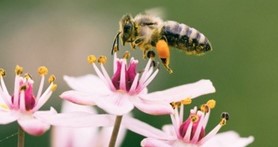
An even better way to reduce use of poison is to plant native plants in place of turf grass. Native species support every sort of insect and other wildlife that are also native, including butterflies and birds.
Are you convinced yet?
Okay, you say, I’d love to forego regular chores of weeding, trimming, thatching, reseeding, and more. But how do I replace the lawn and what do I replace it with?
First, I release you from the arduous chore of digging up turf. If a shaded patch of yard is transitioning to moss, let the mosses be. However, in sunny patches, where un-irrigated lawn turns brown in the dry summer months and springs back to life when it rains, a less energy-consuming method works well.
Gather cardboard from any source you can think of. Remove plastic tape. Either begin small and replace patches of lawn at a time or wait until you have stockpiled twice as much grass-smothering cardboard as you think you will need.
The lazy woman’s method:
Give the lawn one last (sniff!) mowing. Leave clippings in place, preferably before days of rain. Then “shingle” cardboard over the lawn. Cover every slimmest possible gap that pernicious grass can escape through. Overlap layers at least three to four deep over the entire space. At the very least, two layers everywhere and more where edges stack over one another. Wet it well. Cover cardboard with at least a few inches of compost. Pile mulch over it all.
When we took on the main front lawn, after covering the side and back yards and planting shrubs and raised beds, we got help from a Snohomish Conservation District rain garden crew.
In Process:
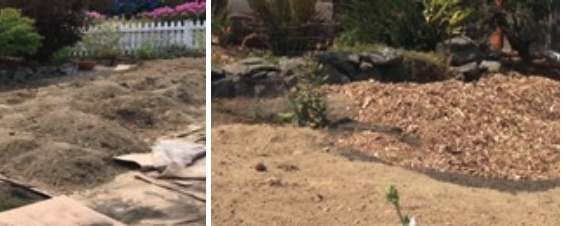
What to plant instead of grass:
When the fall rains returned, we planted. For those who want an extremely low-maintenance expanse of low-growing ground cover, one of the easiest, rapid-growth plants is creeping thyme (the bees LOVE it and so do the bunnies). Several varieties of thyme are available as “steppables” and a few plants will soon create a mosaic.
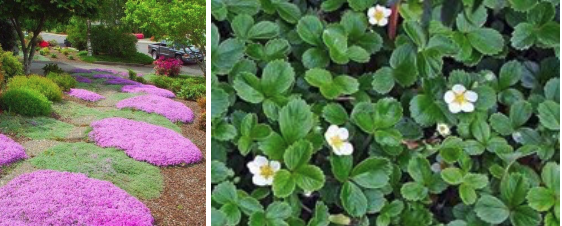
L-R: Creeping thyme and beach strawberry
As for native groundcovers, Fragaria chiloensis (beach strawberry) does not set fruit of any significance and will create a dense ground cover no matter what the soil, given a little shade.
Sedums (broad-leaved stonecrop, Sedum spathulifolium, or spreading stonecrop, Sedum divergens) are succulents that require no watering, have lovely little flowers, and great fall color.
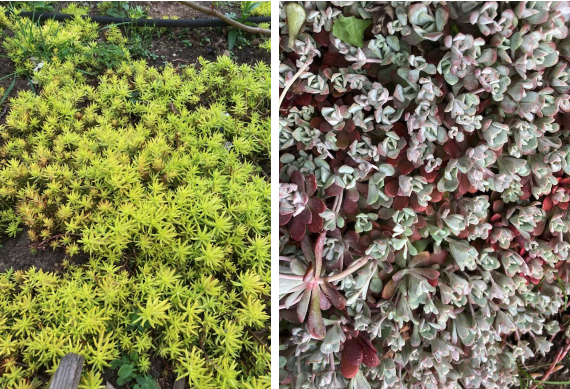
L-R: Sedum Angelina stonecrop and Sedum spathulifolium
Inside-out flower Vancouver hexandra, will die back in winter and spread its delicate-looking heart-shaped leaves in a fluffy mat with the tiny pink pairs of flowers dangling from wiry stems in late spring.
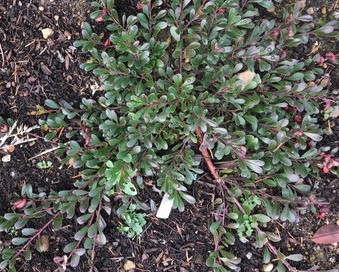
Kinnikinnik
Kinnikinik may take a little time to get started, but once it gets established will cover large swathes of sandy, poor soil in full sun and delight with heather-like flowers and berries for wildlife.
Our first fall with the new garden, an overzealous weeder pulled all the Trientalis latifolia (Starflower) from one planting bed. Despite our dismay, it came back and multiplied the next spring and continues to spread. It likes a wooded spot with partial shade.
There are so many more. However, these are the ones we have found to be the easiest to obtain and care for, or, rather, neglect with success.
The best source of information about plants that will work for your yard is King County’s native plants resources website.
The Snohomish Conservation District holds a native plant sale every spring. Learn about ordering at: www.theplantsale.org.
And if you are ready to plant now, the Edmonds Floretum Garden Club plant sale takes place the first Saturday of May at the Edmonds United Methodist Church parking lot, 828 Caspers St.
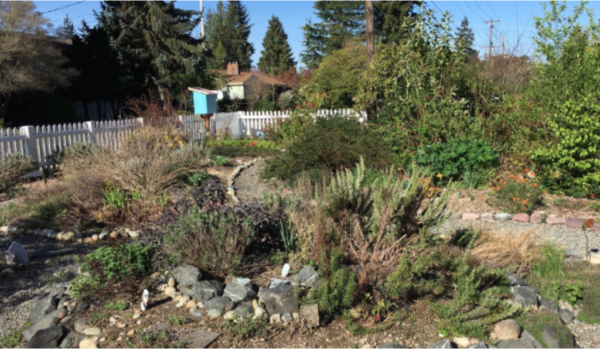
Our yard currently, four-and-a-half years later to compare with the “Before” photo.
 Lora Hein gardens in Edmonds. She earned her degree in environmental studies and biology at Sonoma State University and landed in Washington the following year as a backcountry ranger with the North Cascades National Park. After seven summer seasons with NOCA, for the next 30 years she cloned rhododendrons, designed passive solar homes, inspected air pollution control, taught elementary school, and became a UniServ field representative for public education employees, from which she recently retired. She is currently writing a memoir about her experiences as the first female backpacking ranger in Yosemite and blogs at https://www.lorahein.com.
Lora Hein gardens in Edmonds. She earned her degree in environmental studies and biology at Sonoma State University and landed in Washington the following year as a backcountry ranger with the North Cascades National Park. After seven summer seasons with NOCA, for the next 30 years she cloned rhododendrons, designed passive solar homes, inspected air pollution control, taught elementary school, and became a UniServ field representative for public education employees, from which she recently retired. She is currently writing a memoir about her experiences as the first female backpacking ranger in Yosemite and blogs at https://www.lorahein.com.
She became a Certified Sustainable Building Advisor in 2012. She has been a member of the Edmonds Floretum Garden Club since moving to Edmonds. In 2018, she and her spouse, Nora Carlson, received the Snohomish Conservation District’s Conservationists of the Year – Urban and Suburban Homeowners Award in recognition of their conversion of a plain lawn into a garden that neighbors stop by to ask about. You can read more about their lawn transformation at www.lorahein.com/bee-ing-a-leader/ and also at www.lorahein.com/better-ground-promotes-conservation-districts
